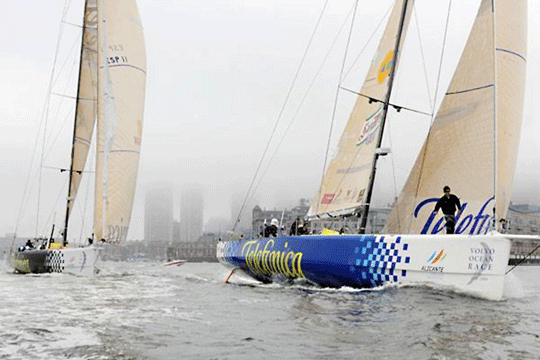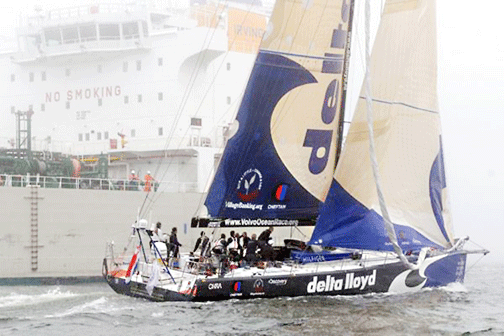
Volume XVII, Issue 22 # May 28 - June 3, 2009 |
 |
The Volvo Ocean Race, Leg 7
Running the gauntlet from whales to sea turtles from Boston to Ireland
by Steve Carr
 |
| Telefonica Blue and Telefonica Black lead the fleet, above, as the boats head out of Boston and into the Atlantic on Leg 7 to Galway, Ireland. Delta Lloyd, below, was forced to change course to avoid the freighter Nor'easter as it appeared out of the fog. |
 |
![]()
This year was Boston’s moment in the sun, as the Volvo Ocean Race bypassed our homeports of Annapolis and Baltimore to go north. Boston recently completed its Fan Harbor facelift as part of the Big Dig road project through downtown, so this new facility, and the city’s rich maritime history, were in the spotlight.
The Volvos were treated to a first-class show, featuring tickets for the crews to the Boston Celtics and Bruins playoffs, the college national sailing championship, concerts and street festival performances, Cinco de Mayo parties, a Youth Optimist and laser regatta and Irish cooking demonstrations. The crowds were large and the people of Boston, while not as energized by sailing as their brothers and sisters in Annapolis, provided an entertaining several weeks for the Volvo family to recuperate before their perilous ride across the North Atlantic.
As the boats do at every stop, they raced in-port during the stopover. In Boston, Telefonica Blue continued its in-port dominance, picking up valuable points on its nearest rivals, PUMA and overall leader Ericsson 4.
The Atlantic Obstacle Course
The Volvo 40s began Leg 7 with demons lurking. Telefonica Blue’s skipper Bouwe Bekking four years ago captained the Spanish entry Movistar, which sank during this leg when her keel broke. The ghost of Hans Horrfevoets, the brave Dutchman who was swept off ABN AMRO Two three years ago, also haunted the fleet.
Under a cool fog, this last ocean leg began with near tragedy. Rounding the weather mark at the mouth of the harbor, Delta Lloyd almost hit an incoming freighter.
The boats rocketed north toward Nova Scotia through an obstacle course, dodging lobster pots, fishing boats and whales. Near misses were the order of sailing, and each boat snagged multiple pots day and night.
“Today we were confronted by hundreds of lobster pots,” Ian Walker of Green Dragon lamented. “After zigzagging our way through we eventually hooked one on our leeward daggerboard. Five minutes later we had three of them entangling us.”
Day two found the boats within eyesight of one another in a strong southerly breeze as they cleared Cape Sable Island and headed for the scoring gate off of Newfoundland. Conditions worsened as the Labrador Current pushed the fleet north and lowered temperatures to the breaking point.
PUMA’s media member Rick Deppe described the weather as “Freezing. I mean really freezing — it’s bone-chillingly cold even down below where I’m hiding right now. Add to the cold a thick, dense fog that has descended all around us. This fog of course makes life extremely damp.”
As fog covered the fleet in a thick blanket for days, stress levels rose.
Wrote PUMA’s skipper Ken Read: “Not only is the distance between the boats ridiculously close, it is impossible to cover anyone. The fog is so thick that you can barely see the bow of the boat, never mind the competition.”
Close quarters continued to the scoring gate, with Telefonica Blue in first, only 30 seconds ahead of PUMA, and with Ericsson 4 close on their tails.
The easterly course took the boats to the edge of the Ice Exclusion area, a huge swath of the North Atlantic off limits because of the threat of icebergs. The boats at the back ignored the scoring gate and headed south first and into the lead.
Meanwhile, Ericsson 3 hit a whale and joined Green Dragon with a damaged dagger board.
Navigator Aksel Magdal radioed in: “We managed to avoid the first whale, but we only saw the tail of the next one as it dived just in front of us. The boat came to a complete stop with some bad noises from our appendages. We could see that the keel fin fairings were damaged. We hope the whale got away only with some bruises, we did what we could to avoid it.”
Whales to Turtles and Lost Rudders
Once around the ice-box danger zone, the boats gybed north, rocking and rolling inside a low-pressure rocket sled of 40-plus-mile winds over a Maytag sea.
Then came the turtles, the endangered Dermochelys coriacea — or leatherback turtles.
 |
| Shannon Flacone lifts a new rudder into place aboard PUMA. |
![]() On Telefonica Black, navigator Rodger Nilson e-mailed: “Suddenly the whole boat started to vibrate and the steering felt very strange. David [Vera] took the endoscope to inspect the keel and daggerboard. He burst out into roaring laughter, ‘There is a big turtle stuck on the leading edge of the keel. Unbelievable!’ ”
On Telefonica Black, navigator Rodger Nilson e-mailed: “Suddenly the whole boat started to vibrate and the steering felt very strange. David [Vera] took the endoscope to inspect the keel and daggerboard. He burst out into roaring laughter, ‘There is a big turtle stuck on the leading edge of the keel. Unbelievable!’ ”
The fleet was now sailing in ideal conditions, running downwind, with spinnakers proudly unfurled into the biting jaws of a fierce North Atlantic storm, pushing them straight toward Galway, Ireland. Ericsson 4 forged into the lead, covering 538 miles in 24 hours.
But PUMA’s hard luck was not over.
“All of a sudden we got a pretty nasty puff and we were off,” wrote Skipper Ken Read. “I heard a bang at the back of the boat and the leeward rudder had sheared off.”
Stealing into Galway
The last tactical decision: How far north to head before banging it east, reaching in high winds toward Galway.
With 700 miles to the finish, the Ericsson twins went into stealth mode to cover their tracks and ensure that no one would know when they made their turns. Soon, every boat but Telefonica Black was in hiding.
When they emerged from darkness, it was a full-on sprint to the finish. Ericsson 4 took line honors, PUMA second and hometown favorite Green Dragon third. Torben Grael and the Swedish boat Ericsson 4 reached Galway with a commanding 14.5 point lead and only three more legs and two in-port races to go.